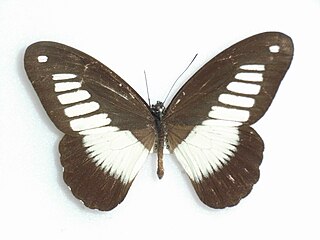
The Congo white-toothed shrew is a species of mammal in the family Soricidae. It is found in Democratic Republic of the Congo and Uganda. Its natural habitat is subtropical or tropical moist lowland forests. It is threatened by habitat loss.

The Railer bat is a species of bat in the family Molossidae. It is found in Cameroon, Central African Republic, Republic of the Congo, Democratic Republic of the Congo, Ivory Coast, Equatorial Guinea, Gabon, Ghana, Guinea, Kenya, Liberia, Nigeria, Rwanda, Sierra Leone, and Uganda. Its natural habitats are subtropical or tropical dry forests and subtropical or tropical moist lowland forests. It is threatened by habitat loss.

Lovoa trichilioides, also called African walnut, Congowood, dibetou or tigerwood, is a species of plant in the family Meliaceae. It is found in Angola, Cameroon, the Republic of the Congo, the Democratic Republic of the Congo, Ivory Coast, Gabon, Ghana, Liberia, Nigeria, Sierra Leone, Tanzania, and Uganda. It is threatened by habitat loss. Germination success is somewhat limited by short-lived seeds which are heavily predated. Exploitation rates are high. It is one of the two principal timber species in Congo.
Vepris lecomteana, synonym Oricia lecomteana, is a species of plant in the family Rutaceae. It is found in Cameroon, the Republic of the Congo, Gabon and Nigeria. Its natural habitat is subtropical or tropical moist lowland forests. It is threatened by habitat loss.
Vepris suaveolens, synonym Oricia suaveolens, is a species of plant in the family Rutaceae. It is found in Cameroon, the Central African Republic, the Democratic Republic of the Congo, Ivory Coast, Ghana, Guinea, Liberia, Nigeria, and Sierra Leone. It is threatened by habitat loss.
Vepris glaberrima, synonym Oriciopsis glaberrima, is a species of plant in the family Rutaceae. It is native to Cameroon, the Central African Republic, the Republic of the Congo and Gabon. It is threatened by habitat loss.
Pouteria altissima is a species of plant in the family Sapotaceae, and a source of anigre hardwood. It is found in Burundi, Cameroon, Central African Republic, the Republic of the Congo, the Democratic Republic of the Congo, Ivory Coast, Ethiopia, Gabon, Ghana, Guinea, Kenya, Nigeria, Rwanda, Sierra Leone, Sudan, Tanzania, and Uganda. It is threatened by habitat loss.
"Teclea carpopunctifera" is a small forest tree in the family Rutaceae. The genus Teclea has been synonymized with Vepris, but this species appears not to have been given a name in Vepris and is regarded as "unplaced" by Plants of the World Online. It is endemic to Côte d'Ivoire.
Vepris allenii is a species of plant in the family Rutaceae. It is endemic to Mozambique.
Vepris arushensis is a species of plant in the family Rutaceae. It is endemic to Tanzania.
Vepris borenensis is a species of plant in the family Rutaceae. It is found in Ethiopia and Kenya.
Vepris glandulosa is a species of plant in the family Rutaceae. It is endemic to Kenya. It is threatened by habitat loss.
Vepris heterophylla is a species of plant in the family Rutaceae. It is found in Burkina Faso, Cameroon, Ghana, and Mali. It is threatened by habitat loss.
Vepris samburuensis is a species of plant in the family Rutaceae. It is endemic to Kenya.
Vepris sansibarensis is a species of plant in the family Rutaceae. It is found in Kenya and Tanzania.
Vepris trifoliolata is a species of plant in the family Rutaceae. It is endemic to Cameroon. Its natural habitats are subtropical or tropical moist lowland forests and subtropical or tropical moist montane forests. It is threatened by habitat loss.

Papilio constantinus, the Constantine's swallowtail, is a butterfly of the family Papilionidae. It is found in Sub-Saharan Africa.

Papilio cynorta, the mimetic swallowtail or common white banded papilio, is a butterfly of the family Papilionidae. It is found in Africa, including Sierra Leone, Liberia, Ivory Coast, Ghana, Togo, southern Nigeria, Cameroon, Equatorial Guinea, the Democratic Republic of the Congo, Angola, the Republic of the Congo, Uganda, Kenya and Tanzania.

Papilio phorcas, the apple-green swallowtail or green-banded swallowtail, is a butterfly of the family Papilionidae. It is found in Africa.
Bocage's African fat mouse is an extant species of rodent indigenous to Angola, the Republic of the Congo, and the Democratic Republic of the Congo (DRC). Given the distribution of the species across the Angolan Plateau and south-west of the DRC throughout central Africa, the probability of a 'large population', and the security of its habitat, the International Union for Conservation of Nature (IUCN) recognises S. bocagei as stable. Whereas taxonomies early in the twentieth century posit S. bocagei as a species, more contemporary records from 1977 onwards identify it as indistinguishable from S. pratensis. In 1998, however, Crawford-Cabral proposed that the additional pair of teats in S. bocagei required separation from S. pratensis. Subsequent to Crawford-Cabral's publication, Wilson and Reader maintain in Mammal Species of the World that the size of these species also requires differentiation, where S. bocagei is significantly larger than S. pratensis and is unique or otherwise corresponds to S. opimus.






